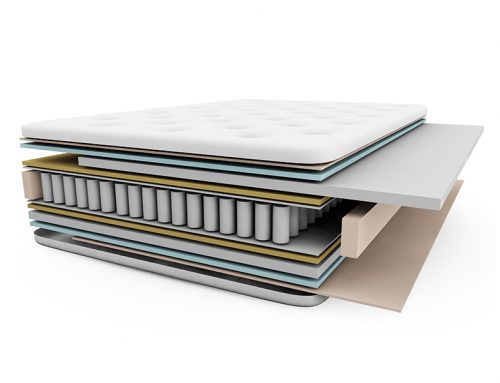Outside of a few alternative or luxury choices, it’s now unusual to find a mattress without some foam in its construction. So, unless you’re looking for an all-natural product, or a handcrafted traditional model, the first decision you’ll need to make regarding your new sleeping surface is whether you’d prefer an all-foam mattress or one that combines foam with an innerspring core.
The path towards foam
A quick recap of how foam became mainstream in mattress manufacturing. Back in the day, a mattress meant springs—these were normally unpredictable, sometimes saggy and poke-y coils that were intended to form a responsive surface for your body weight.
Taking inspiration from the coils in chairs and other furniture, James Marshall introduced the concept of wrapped coils to mattresses at the very end of the nineteenth century. Since then, manufacturers have been continually experimenting with ways to keep coils aligned, functional, and responsive to sleepers.
But while an innerspring might give you support, they’re probably not so great as a sleeping surface in themselves. As a solution, the foundation layers of a mattress are overlaid with a comfort layer. When polyurethane (poly) foam became a ubiquitous material in the mid-twentieth century, foam toppers replaced cotton, wool, and other natural fibers as a way of matching the support of a mattress with a luxurious sleep experience.
In the past couple of decades, developments in foam have turned basic polyurethane into a variety of different density foams, designed for different body weights and sleeping preferences. This led to the birth of the first spring-foam hybrid mattress, where foam crept down from the comfort layer into the core. By the time memory foam entered the scene in the 1990s, foam tech had reached the point where springs could be removed altogether, giving a different kind of sleeping experience.
Other options (very quickly)
In case you weren’t aware, there is a third option in this debate. A handful of manufacturers are still producing mattresses without using any foam at all—though, you’ll likely be paying a little more for this kind of bespoke design.
Some brands still make an old-fashioned innerspring mattress with tufted cotton padding, which can then be paired with a traditional wool topper for a retro experience. Others make simple mattress pads from cotton (think futons or basic floor pads, worth trying out if you love very firm beds).
Alternatively, a growing number of manufacturers are focusing on organic or all-natural construction methods, leading to a rise in latex mattresses. Latex replicates foam as far as its ability to match the contours of your body, dispersing the pressure that can form on your shoulders, hips, and lower back depending on your sleeping position. It may even be better for regulating temperature, though some call out latex mattresses for their poor levels of motion transfer.
Foam pros +
Ok, so with the background information sorted, let’s look at the pros and cons of both foam and hybrid constructions.
Foam mattresses are often marketed as the product for you if you enjoy the feeling of sinking into a bed—having your sleeping surface match the shapes and weight of your body as you change position throughout the night. Much of this marketing stems from the introduction of memory foam as a mattress material in the 90s/2000s. Memory foam is a specially treated version of poly foam that changes density upon contact with heat and weight, meaning that it visibly responds to your body as you lie down.
Memory foam is a great option if you’re looking for a softer, more flexible sleeping surface. But there’s a lot more to the foam market than a pure memory foam bed. Many of today’s manufacturers will use memory foam as one of several comfort layers, building up different polyurethane densities above a solid foam core. As you place your weight onto the mattress, heavier points—especially your hips—sink to lower, denser layers than light points such as your limbs, which float on the softer layers.
One of the latest innovations in this area is the ‘zoning’ of extra support to relieve pressure in key areas for a comfortable sleep, such as the shoulders and lower back.
Foam cons –
Memory foam has a reputation for retaining heat, leading to the possibility of an uncomfortable night, no matter the level of support. There’s definitely truth to this claim, with older and original versions of pure memory foam beds yielding disappointment from sleepers who parted with serious cash for the latest in sleep systems. However, pick up a memory foam mattress today, and it’s likely the foam will be infused with gel or other structure-altering materials, creating a foam that’s better at regulating airflow and heat loss.
The biggest argument against today’s foam mattresses relates back to the full foam core, which aims to replicate the responsiveness of springs through high-density polyurethane. Generally speaking, a foam foundation will never match that ‘bounce-back’ sensation of a good spring mattress, giving foam beds more of a solid and dense feel. While some sleepers readily adapt to this sensation, others may miss the ‘springiness’ of a hybrid mattress.
That said, it’s worth remembering that alternative foam options such as latex foam are judged by many to completely close the gap between foam and spring cores, making the choice more about cost and personal preference than the technical specs.
Hybrid pros +
If you are one of those sleepers who value the bounciness of springs, a hybrid mattress is intended to give you that responsiveness without sacrificing the pressure-relieving ability of foam.
Hybrid models use the same layering approach to add comfort and give across the surface of the bed. Depending on price and quality, this again means memory foam or other high-density materials that will accommodate a variety of weights and sleeping positions. Below that, however, a foam foundation is replaced with a traditional innerspring system.
Most hybrid mattresses opt for pocket springs—individually wrapped coils that create a total are reliable feeling of support, right up to the edges of the bed. This is something that foam constructions simply cannot match. While all-foam and hybrid models may provide a near-on identical sleep experience in the middle of the bed, foam mattresses will give at the edges, whereas the metal coils in a hybrid keep things structured everywhere.
Hybrid cons –
Because foam cores are less responsive, they’re generally better at isolating movement than a sprung foundation. So while you’re likely to get more bounce from a hybrid mattress, you’re also more likely to feel your sleeping partner shifting around during the night—if you’re planning to share your new mattress.
While budget options are available, foam-spring hybrids also tend to come with a higher price-point than the average foam mattress, due to the complexity of construction, and the recentness of many hybrid technologies.
A side by side comparison
| Foam construction | Hybrid construction | |
|---|---|---|
| Weight distribution | ✓ | ✓ |
| Pressure-point support | ✓ | ✓ |
| Accommodates all weights | ✓ | ✓ (very light people may struggle to compress mattress core) |
| Edge support | ✓ | |
| Better for soft mattresses | ✓ | |
| Better for firm mattresses | ✓ | |
| Movement isolation / absorption | ✓ | |
| Temperature regulation | ✓ (In modern models) | ✓ |
| Feel | Sinking into the bed | Floating on top of the bed |
| Budget models available | ✓ | ✓ |
Conclusion
If you’re trying to make the decision between a hybrid and all-foam mattresses, you’re already thinking along the right lines—as these two types of construction represent the contemporary field of mattress technology. If you have a little more budget to spare, and you prioritize a responsive feel, edge support, and temperature regulation, then a hybrid mattress may be the one for you. Alternatively, those who prefer movement isolation and a feeling of deep support might want to take a closer look at foam options.





